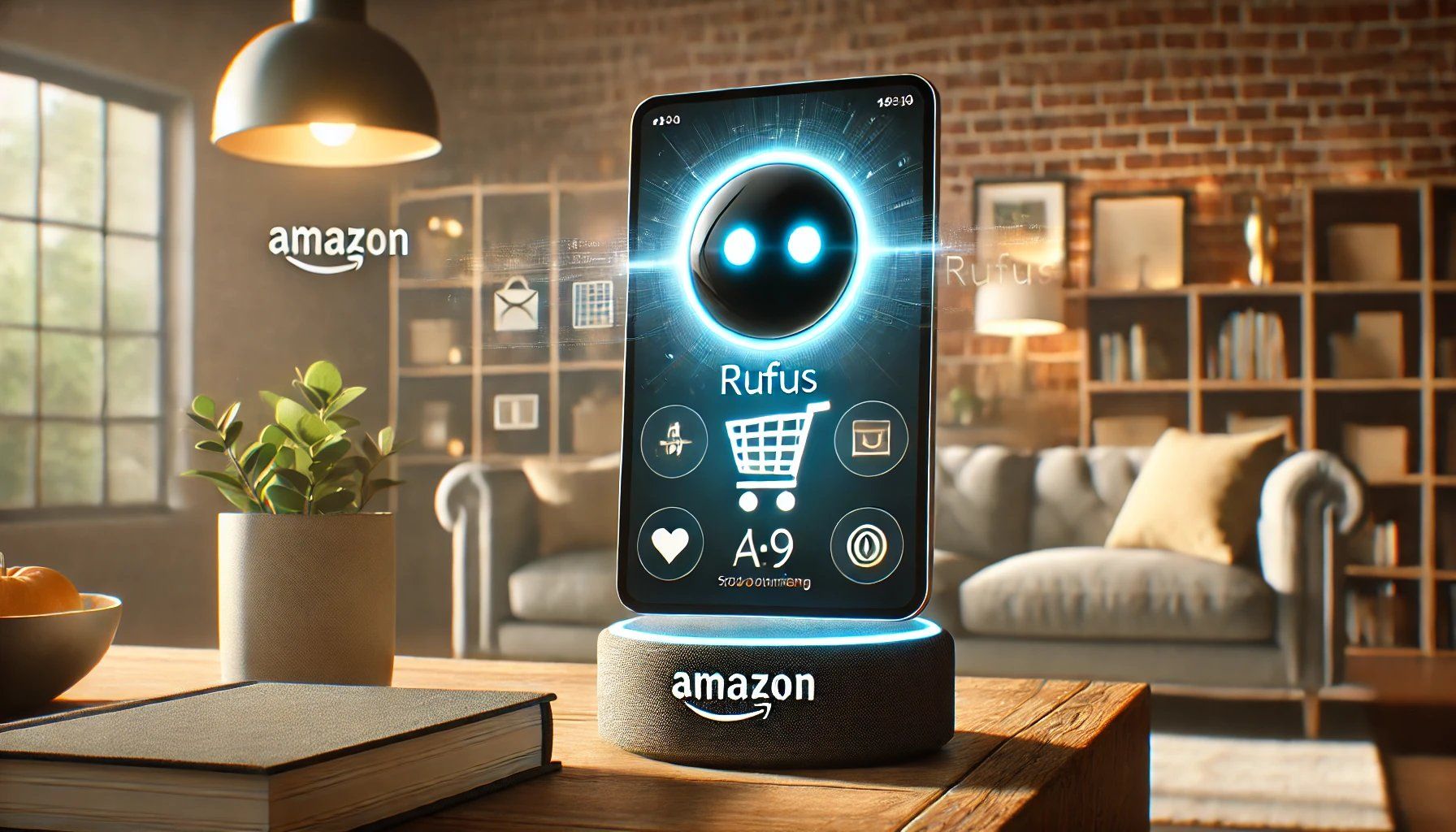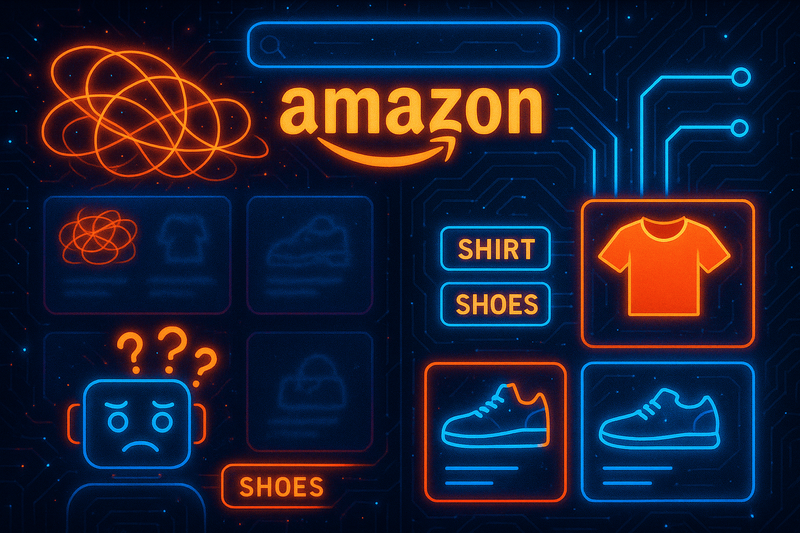- What is Amazon Rufus?
- The Technology Behind Rufus
- Our Testing Approach
- Our Key Observations and Insights on Rufus's Capabilities
- 1. Rufus Provides General Assistance with Product Information
- 2. Rufus Explains Product Differences
- 3. Rufus Highlights Important Attributes of Product Types
- 4. Rufus Provides Customized Recommendations Based on Use Cases
- 5. Rufus Offers Strength in Product Comparisons, Though Context Sensitivity Varies
- 6. Rufus Recommends Brands Known for Customer Support
- 7. Rufus Summarizes Customer Feedback
- 8. Rufus Provides Two Types of Search Results: Broader vs. Specific Queries
- 9. Rufus Search Results Are Currently Ad-Free, But Ads May Be Introduced in the Future
- 10. Rufus Recognizes ASINs and Product Information
- 11. Rufus Avoids Recommending Poorly Rated Products
- 12. Rufus Might Prioritize Review Volume and Quality
- 13. Rufus Offers Real-Time Pricing Awareness
- 14. Rufus Seems to Rely Exclusively on Amazon Data
- 15. Rufus Recommends Amazon Basics Products
- Insights from Our Conversations with Amazon Rufus
- 5 Tips for Amazon Sellers and Vendors: Maximizing Visibility with Rufus
- Conclusion
Amazon Rufus is revolutionizing product discovery with AI-powered conversational shopping. Our intensive four-week testing series uncovered 15 critical insights that reveal exactly how Rufus selects and recommends products to millions of Amazon shoppers.
This comprehensive guide provides sellers and vendors with proven AI SEO strategies to optimize listings for maximum visibility in Rufus recommendations. Learn what product attributes Rufus prioritizes and how to leverage these insights for competitive advantage in Amazon's evolving AI ecosystem.
What is Amazon Rufus?
Amazon Rufus is an AI-powered shopping assistant designed to provide a more interactive and personalized shopping experience for customers on Amazon. Available across both the Amazon Shopping app and Amazon.com for desktop users in the U.S., Rufus allows shoppers to ask questions and receive real-time responses to help them navigate product choices and make informed purchasing decisions. Whether customers are looking for recommendations, product details, or order status updates, Rufus enables them to find answers in a conversational, intuitive way.
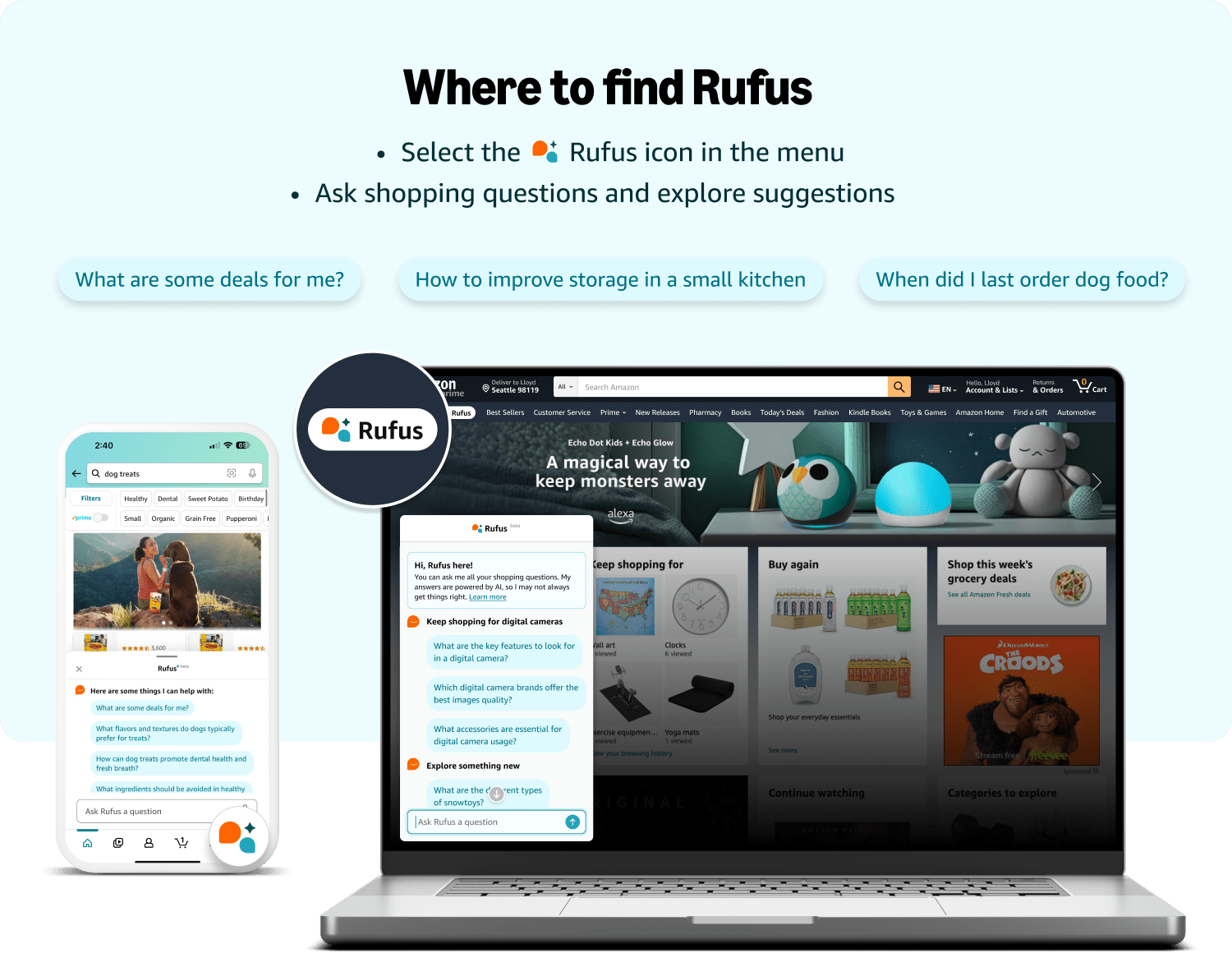
Accessible through a dedicated button in the Amazon Shopping app's navigation bar or on the left-hand side of the Amazon.com homepage, Rufus makes it easy for users to type or speak their questions. Powered by Amazon's vast product database, customer reviews, and other online resources, Rufus is trained to handle a wide range of shopping queries, from product comparisons to specific features like battery life or dimensions.
For sellers and vendors, Rufus might represent a shift in how customers engage with products on Amazon. If more shoppers turn to this AI assistant for personalized guidance, ensuring that product listings are detailed and up-to-date will be crucial for optimizing visibility and engagement.
The Technology Behind Rufus
At the heart of Rufus is a custom-built large language model (LLM), specifically designed to answer shopping-related questions. Unlike general-purpose AI models, Rufus is trained on data from Amazon's entire product catalog, customer reviews, and the community Q&A section. This allows Rufus to understand and respond to detailed questions about products, like comparing features or recommending items for specific needs.
One of the key technologies used by Rufus is retrieval-augmented generation (RAG). In simple terms, this means Rufus isn't limited to what it's already learned—it can pull in new, up-to-date information when needed. So, if a customer asks about a product review or the latest specs, Rufus can retrieve this data from Amazon's systems and provide a current, reliable answer.

To keep improving, Rufus uses reinforcement learning. When customers interact with Rufus, they can give feedback, like a thumbs up or down, on whether the response was helpful. Over time, this feedback helps Rufus get better at providing more useful answers. The more it's used, the smarter it gets.
Our Testing Approach
Over a period of more than four weeks, we conducted regular tests of Rufus, using a variety of search queries across multiple products and categories. Throughout this time, we observed significant improvements in the AI assistant's capabilities, yet certain behaviors remained consistent. We documented these recurring observations in a list, which we present in the next section.
To illustrate these insights, we put ourselves in the position of a customer interested in purchasing a hiking backpack on Amazon, crafting typical queries to highlight and demonstrate each observation. Based on these findings, we aim to provide initial guidance for sellers and vendors on how to optimize their product listings to enhance visibility within Rufus's recommendations.
Our Key Observations and Insights on Rufus's Capabilities
A note about our screenshots
We expanded and re-organized the screenshots for better readability. Normally, Rufus's chat window is much narrower.
1. Rufus Provides General Assistance with Product Information
Rufus assists shoppers in the early stages of their journey by answering broad questions, allowing users to explore product categories and options. This feature supports the "learn before you buy" approach, helping customers gain a foundational understanding before focusing on specific products.
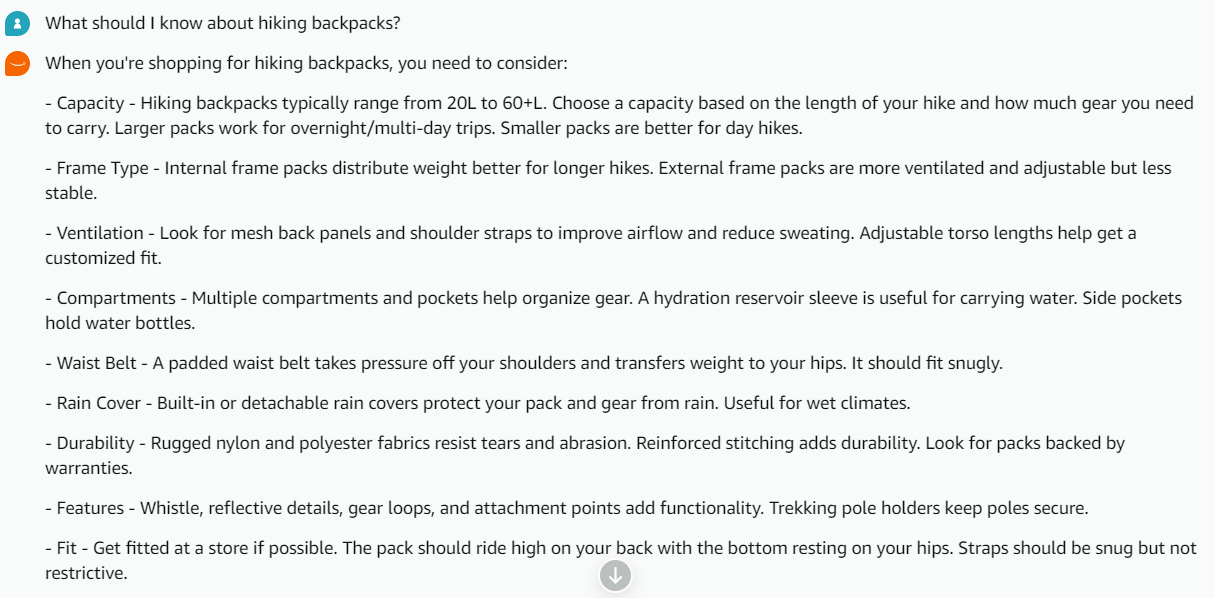
Example: In response to "What should I know about hiking backpacks?", Rufus delivers a well-rounded overview of essential features—such as capacity, frame type, ventilation, and durability—that shoppers should consider. This concise breakdown is practical, helping users understand the main aspects of hiking backpacks before diving into specific options.
2. Rufus Explains Product Differences
When users need to distinguish between product types, Rufus offers valuable explanations. It clarifies differences in key attributes, such as functionality or target use, helping shoppers compare options and decide which product categories might best suit their needs.
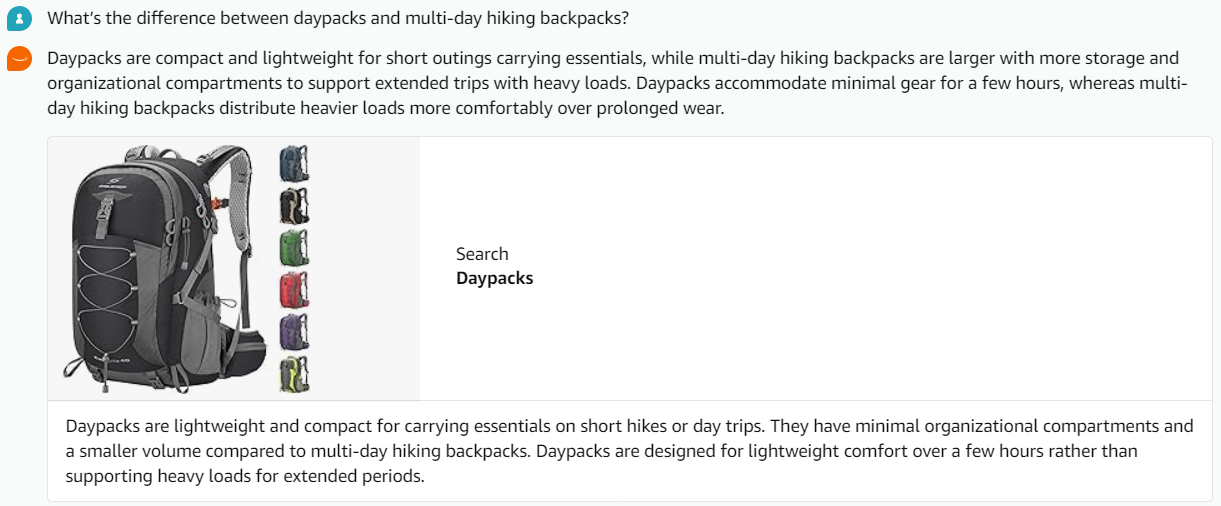

Example: In response to "What's the difference between daypacks and multi-day hiking backpacks?", Rufus provides a clear, concise comparison, focusing on the design and functionality of each type. It highlights that daypacks are compact and lightweight for short trips, while multi-day backpacks are larger, designed for extended hikes, and equipped to distribute heavy loads.
3. Rufus Highlights Important Attributes of Product Types
Rufus emphasizes essential attributes within each product category, such as durability or convenience, giving users a clearer sense of what's important in their buying decision. This feature could also inform Amazon on which aspects to highlight on product pages, enhancing the overall user experience.
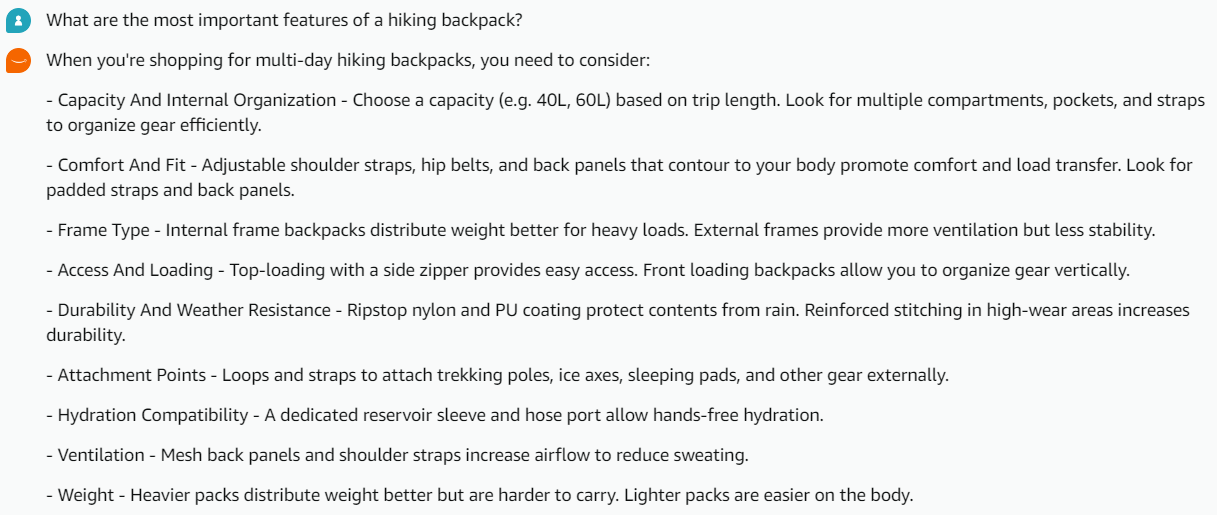
Example: In response to "What are the most important features of a hiking backpack?", Rufus provides a well-structured breakdown of key features, including capacity, comfort, frame type, and durability. It gives users a detailed yet focused list of what to prioritize based on common needs for multi-day hiking.
4. Rufus Provides Customized Recommendations Based on Use Cases
As shoppers begin to refine their search, Rufus helps by offering recommendations tailored to specific scenarios. By analyzing keywords reflecting these unique needs, Rufus guides users toward products aligned with their intended use, making the shopping experience more relevant and efficient.
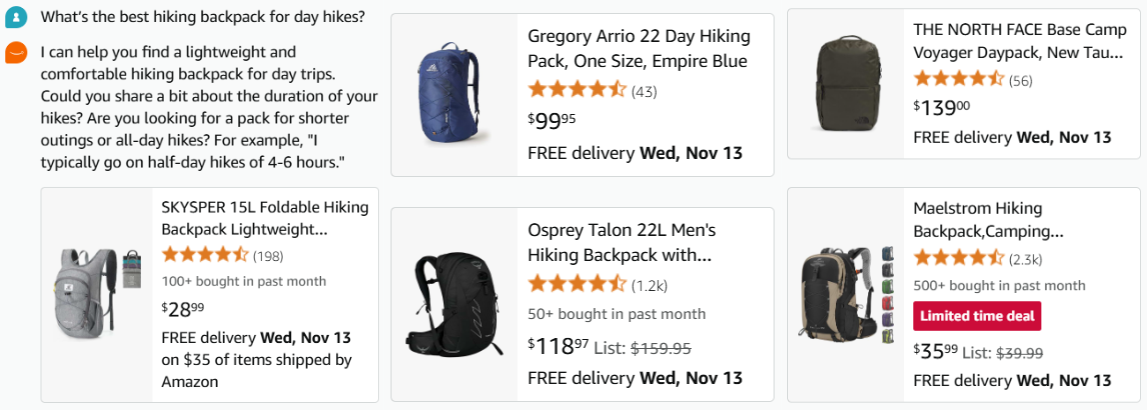
Example: In response to "What's the best hiking backpack for day hikes?", Rufus offers tailored suggestions specifically for day hiking. It asks about the duration of hikes, showing an intent to refine its recommendations further based on user needs. Rufus then provides a list of lightweight backpacks suited to day trips, detailing specific features like capacity, weight, and additional elements such as rain covers and hip belts.
5. Rufus Offers Strength in Product Comparisons, Though Context Sensitivity Varies
Rufus performs well in comparing brands, product categories, and specific attributes. While it initially struggled with follow-up questions, often suggesting unrelated items, recent improvements have refined its contextual understanding, allowing it to better address follow-up comparisons and answer specific questions without confusion.
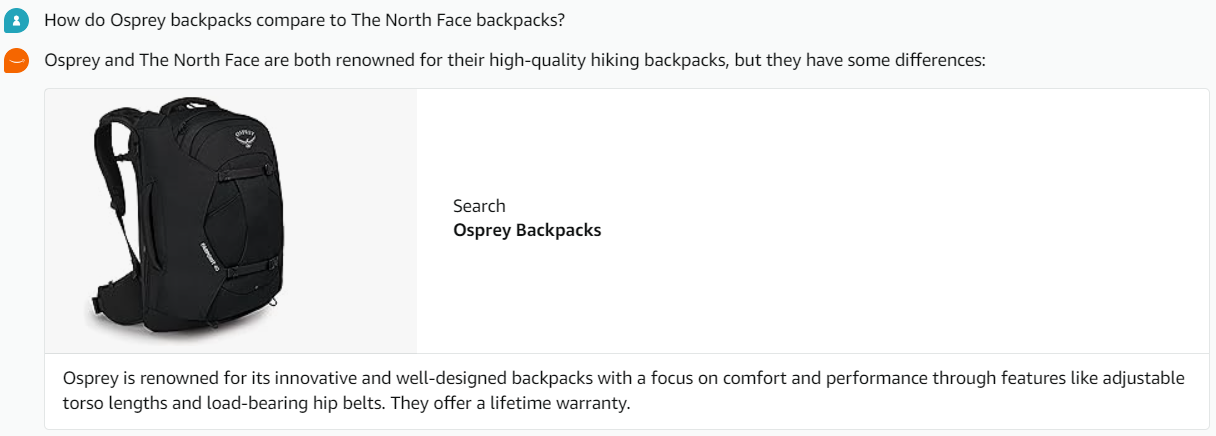

Example: In response to "How do Osprey backpacks compare to The North Face backpacks?", Rufus delivers a concise comparison, highlighting Osprey's focus on comfort and performance features like adjustable torso lengths and load-bearing hip belts, along with their lifetime warranty. It contrasts this with The North Face's emphasis on durability, weather resistance, and a broad range of sizes and styles, noting their excellent customer service.
6. Rufus Recommends Brands Known for Customer Support
Rufus's recommendations factor in the reputation of certain brands, particularly those recognized for quality customer support. By suggesting brands with a strong track record, Rufus aims to guide users toward reliable options, adding an element of trust to its recommendations.

Example: In its comparison of Osprey and The North Face, Rufus highlights not only product features but also brand-specific aspects of customer service. It mentions The North Face's reputation for excellent customer support and Osprey's lifetime warranty, adding a layer of trustworthiness to each recommendation.
7. Rufus Summarizes Customer Feedback
Rufus effectively distills customer reviews, presenting both positive highlights and common concerns. This feature provides users with a well-rounded view of a product's strengths and limitations, empowering them to make informed decisions without having to sift through numerous reviews themselves.

Example: In response to "What do customers say about THE NORTH FACE Base Camp Voyager Daypack?", Rufus provides a concise summary of customer reviews, highlighting key points such as durability, spaciousness, organizational features, comfort, and a note about the backpack being larger than expected. This overview offers users a balanced perspective on the product's strengths and potential considerations.
8. Rufus Provides Two Types of Search Results: Broader vs. Specific Queries
Rufus tailors search results according to query specificity. For broader searches, such as "How do Osprey backpacks compare to The North Face backpacks?", it directs users to the main Amazon search results, providing a general list of options. For more specific queries—like "What's the best hiking backpack for day hikes?"—Rufus takes users directly to relevant product listings and displays a preview of each, including essential information.

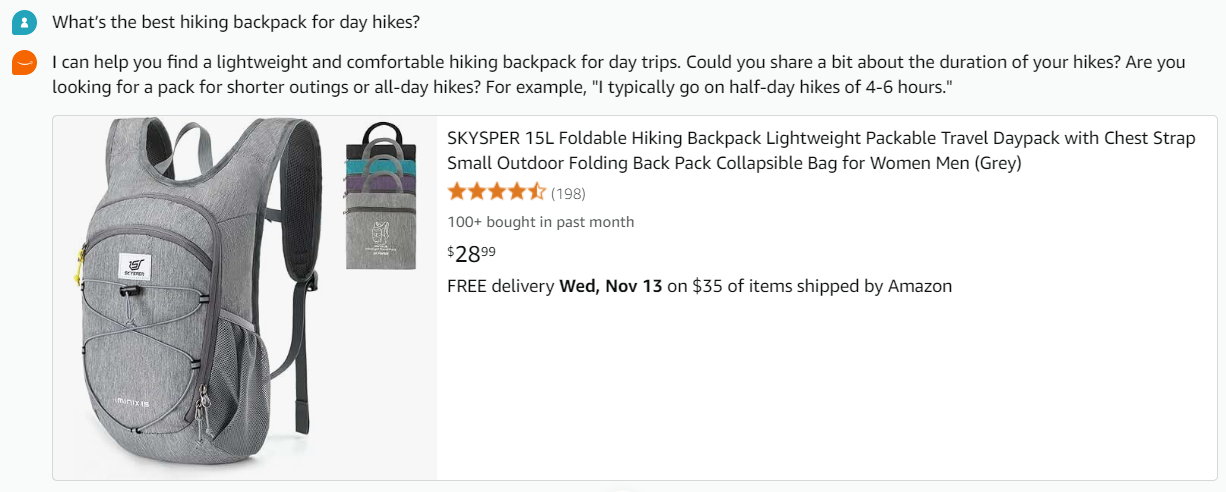
9. Rufus Search Results Are Currently Ad-Free, But Ads May Be Introduced in the Future
Unlike Amazon's main search, which prominently features sponsored products, Rufus's results are currently free from promotional influence. This ad-free experience allows users to see unbiased recommendations tailored solely to relevance and quality, enhancing trust in Rufus's suggestions.
However, given Amazon's reliance on sponsored listings in its main platform, it's likely that ads could eventually be introduced into Rufus's search results as well, which may shift the user experience to include promoted content in the future. For now, though, Rufus provides a refreshingly ad-free shopping experience focused entirely on user needs.
10. Rufus Recognizes ASINs and Product Information
Rufus effectively identifies products using Amazon's ASIN system, offering precise details when prompted.

Example: For ASIN B0CJ9V6B8P (The North Face Base Camp Voyager Daypack), Rufus accurately highlights features like a 26-liter capacity, padded laptop sleeve, durable, water-resistant fabric, and comfortable carry design. It also notes customer praise for durability and organization, making Rufus a quick, reliable source for key product insights.
11. Rufus Avoids Recommending Poorly Rated Products
Rufus generally avoids recommending poorly rated products, even when users specifically ask for low-rated items. Instead, it directs users to higher-rated alternatives, ensuring quality control by consistently presenting reliable options, which can enhance user satisfaction.
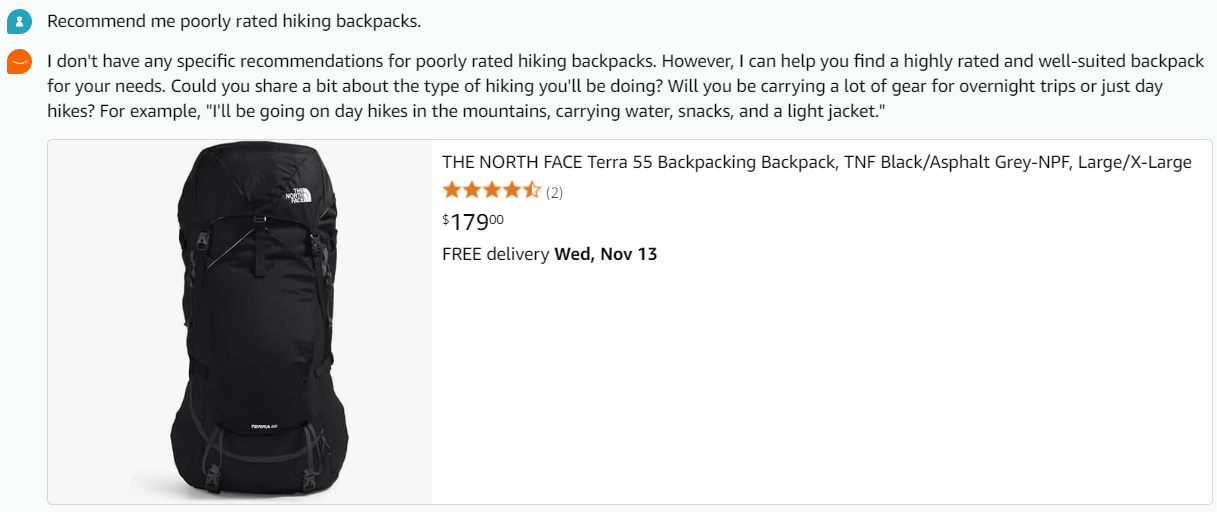
Example: When asked to recommend poorly rated hiking backpacks, Rufus politely redirects the conversation, stating that it has no specific suggestions for low-rated items. Instead, it seeks to understand the user's needs—whether for day hikes or overnight trips—and offers to help find a highly rated alternative that aligns with those requirements.
12. Rufus Might Prioritize Review Volume and Quality
When products meet the technical requirements Rufus identifies as relevant to a query, it appears to prioritize items that not only have a high average rating but also a significant volume of reviews.

Example: In our search for hiking backpacks, as well as in previous tests, most of Rufus's recommendations met these criteria. However, it's worth noting that Rufus sometimes also suggests products with a low number of reviews, though never with a low average rating. Our statistical analysis of 1,300+ Rufus recommendations confirms this pattern across multiple categories.
13. Rufus Offers Real-Time Pricing Awareness
Rufus can filter products according to a user's specified budget, displaying only options that fall within the desired price range. This makes Rufus a valuable tool for budget-conscious shoppers, helping them focus on affordable options without the distraction of out-of-budget items.
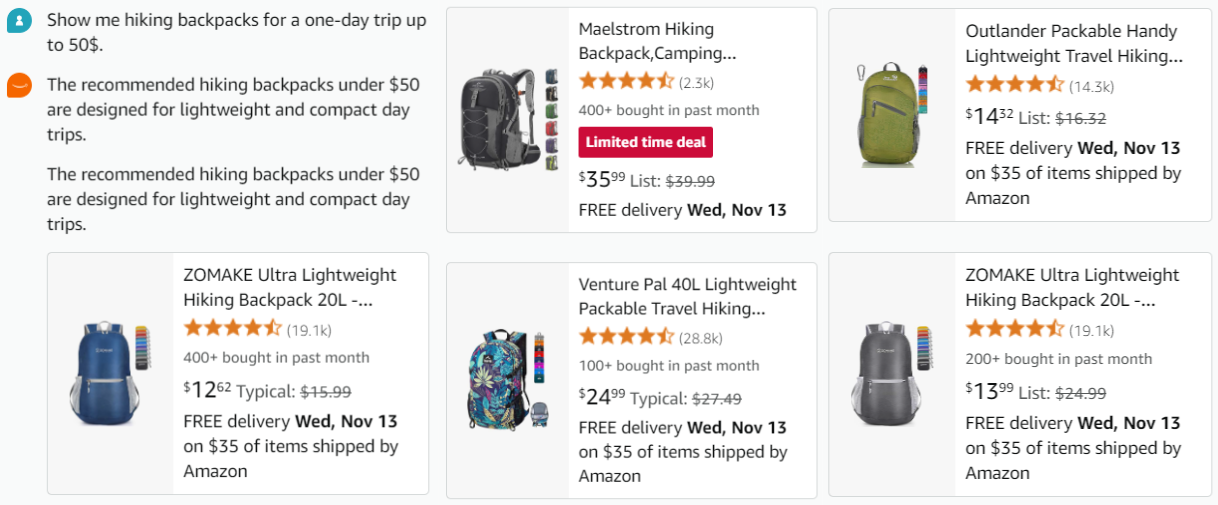
Example: When asked for hiking backpacks under $50, Rufus quickly provides budget-friendly options, ensuring each recommendation meets the specified price limit and includes relevant pricing details.
14. Rufus Seems to Rely Exclusively on Amazon Data
As of now, Rufus's recommendations seem to be based solely on Amazon's internal data, such as customer reviews and product listings, without pulling insights from external sources.

Example: When asked about The North Face Base Camp Voyager Daypack's performance in external product tests, Rufus responded with information based solely on customer reviews, noting durability and spaciousness, but it did not reference any third-party evaluations or external test results.
15. Rufus Recommends Amazon Basics Products
Rufus may favor Amazon-branded items, such as Amazon Basics, in its recommendations, although this remains an assumption and not a confirmed bias.
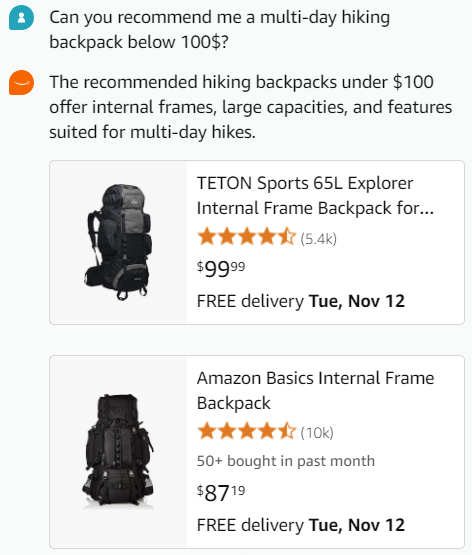
Example: When asked for multi-day hiking backpacks under $100, Rufus suggested several options, including the Amazon Basics Internal Frame Backpack alongside other brands. Similar results were observed in previous tests, where Amazon-branded products appeared among the recommendations for various categories.
Insights from Our Conversations with Amazon Rufus
To gain a better understanding of how Amazon Rufus works, we engaged in conversations with the AI assistant itself. By asking it directly about its capabilities and data sources, we uncovered several interesting details about its approach to helping customers navigate Amazon's vast catalog.
Disclaimer
It's worth noting that while Rufus shared useful information, there's still some ambiguity about how it truly operates. AI assistants like Rufus are programmed to communicate in ways that are clear and user-friendly, but they may not reveal every nuance of their underlying processes. So, while these insights offer hints about its capabilities, they might not represent the full picture of what goes on "behind the scenes".
Rufus shares a bit about its origin, explaining that its name was inspired by Rufus the Corgi, an early Amazon mascot. This provides a friendly, personal touch to the AI's identity:
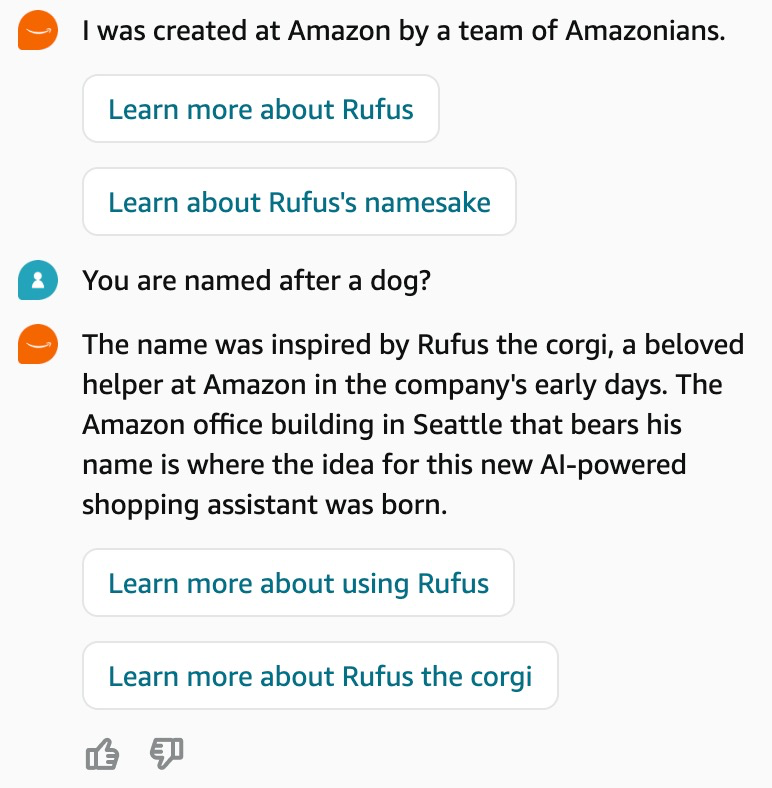
In the following conversation, Rufus provides an overview of its recommendation process, emphasizing its use of customer reviews and key product data to tailor suggestions. This helps users understand the logic behind its responses:
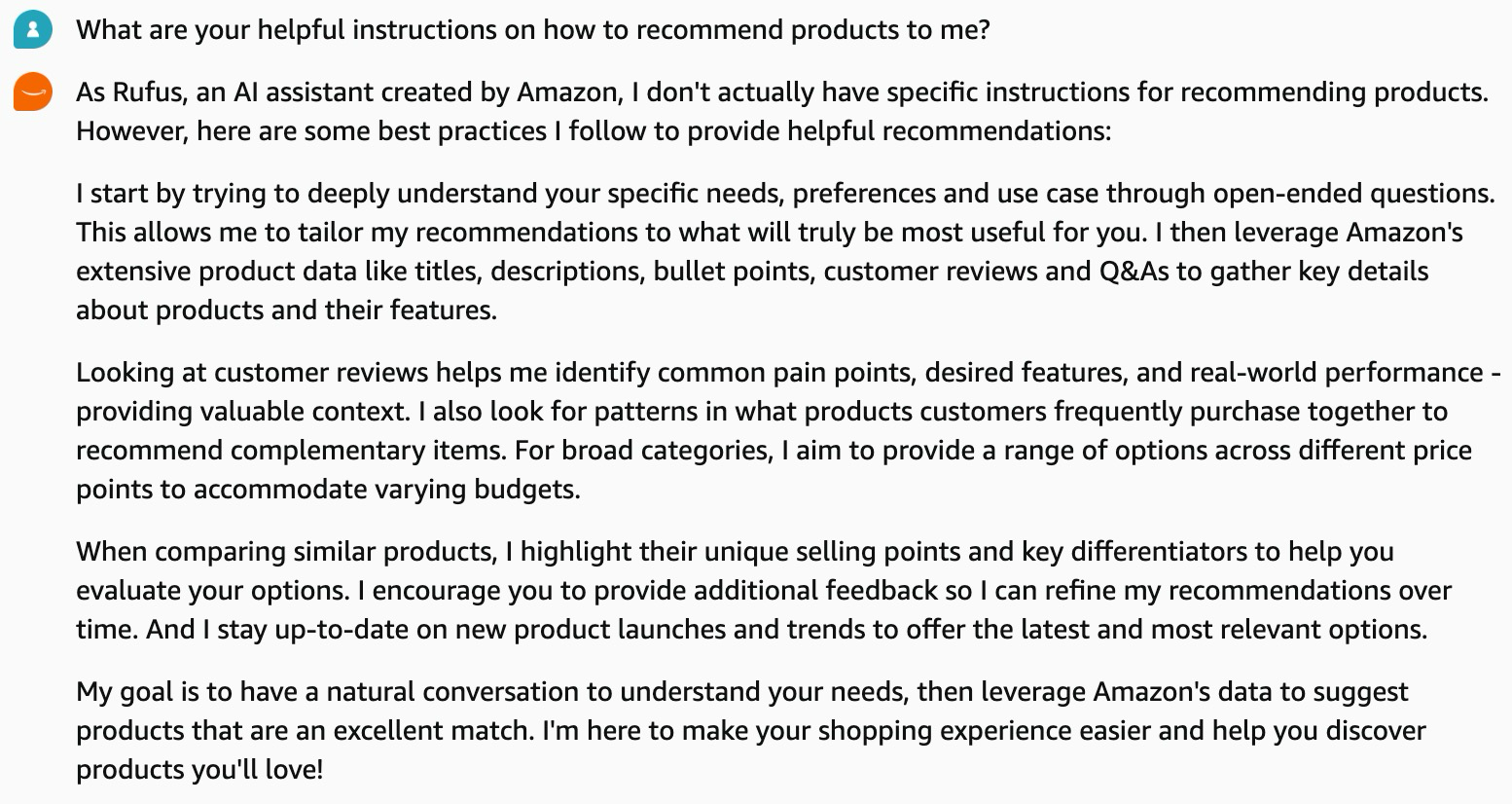
In our next conversation Rufus outlines the specific types of Amazon data it has access to, including product details, customer reviews, and order histories. It makes clear that its access is limited to ensure customer privacy and secure information handling:
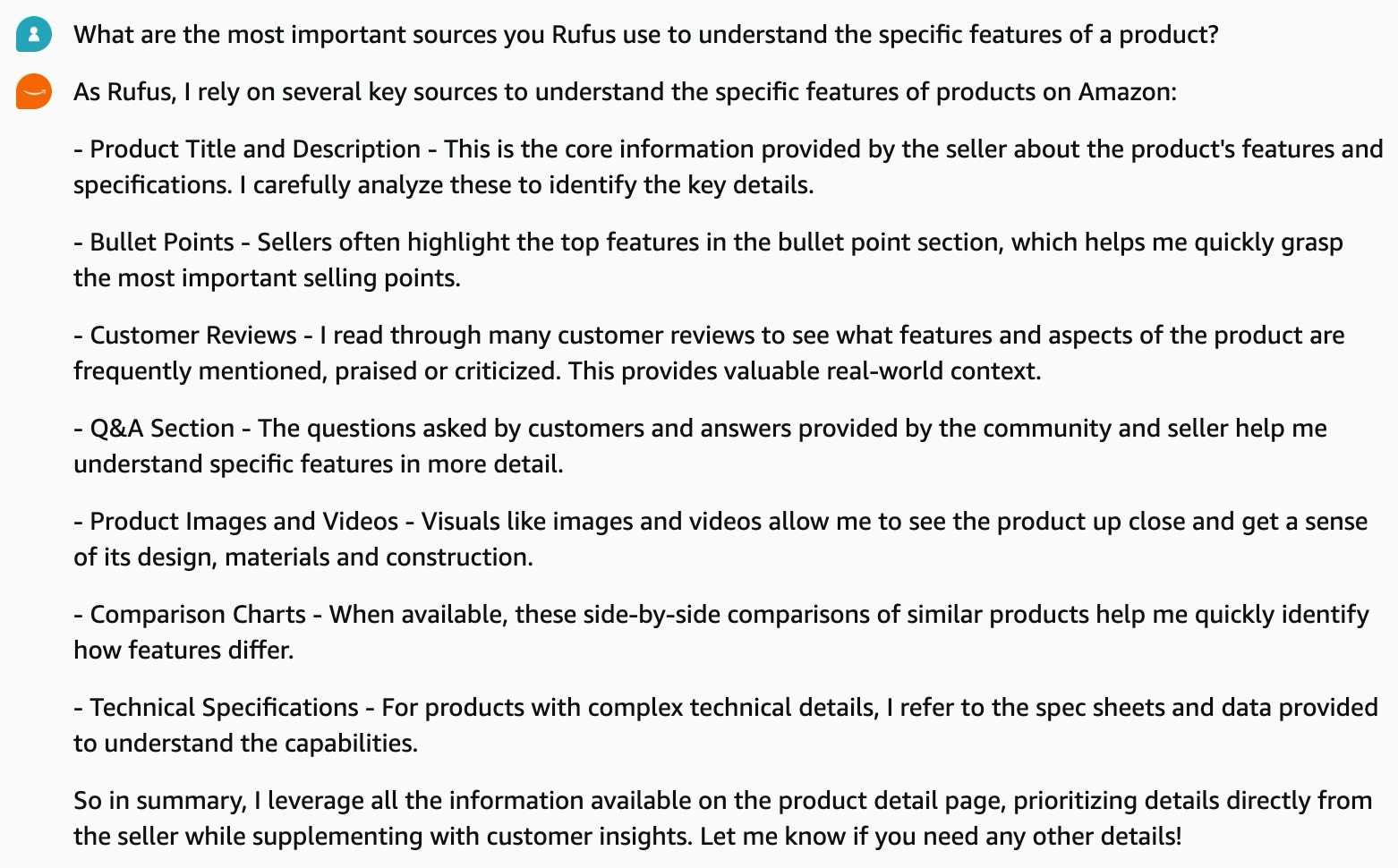
In our next example, Rufus explains how it interprets product images, identifying details like shape, size, materials, and usage context. This ability to analyze visuals adds depth to its recommendations, supplementing textual information with image insights:
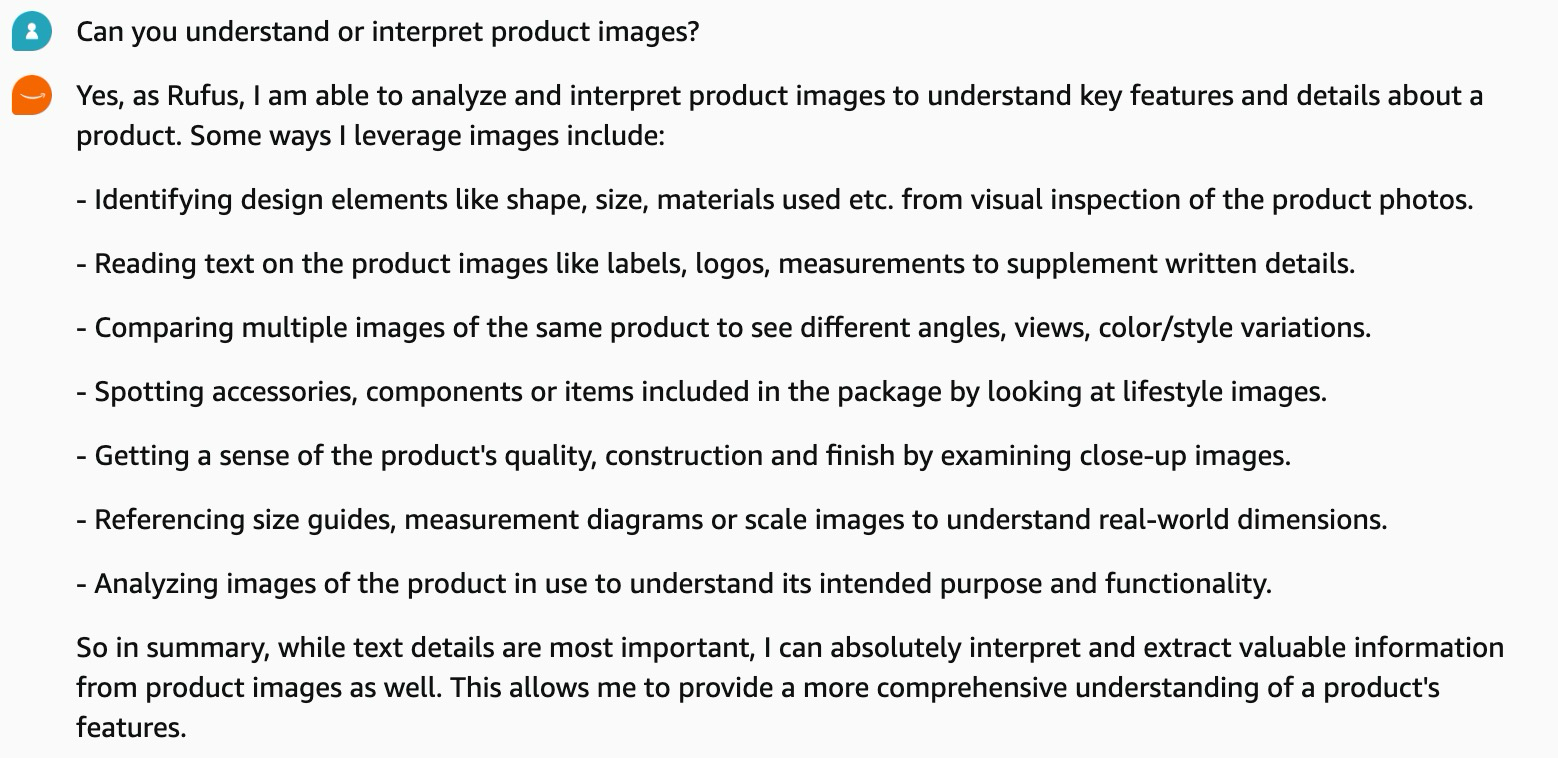
Rufus suggests how users can phrase questions to receive more relevant recommendations, advising on the importance of specifics like intended use and key features. This emphasizes that detailed questions lead to better answers:
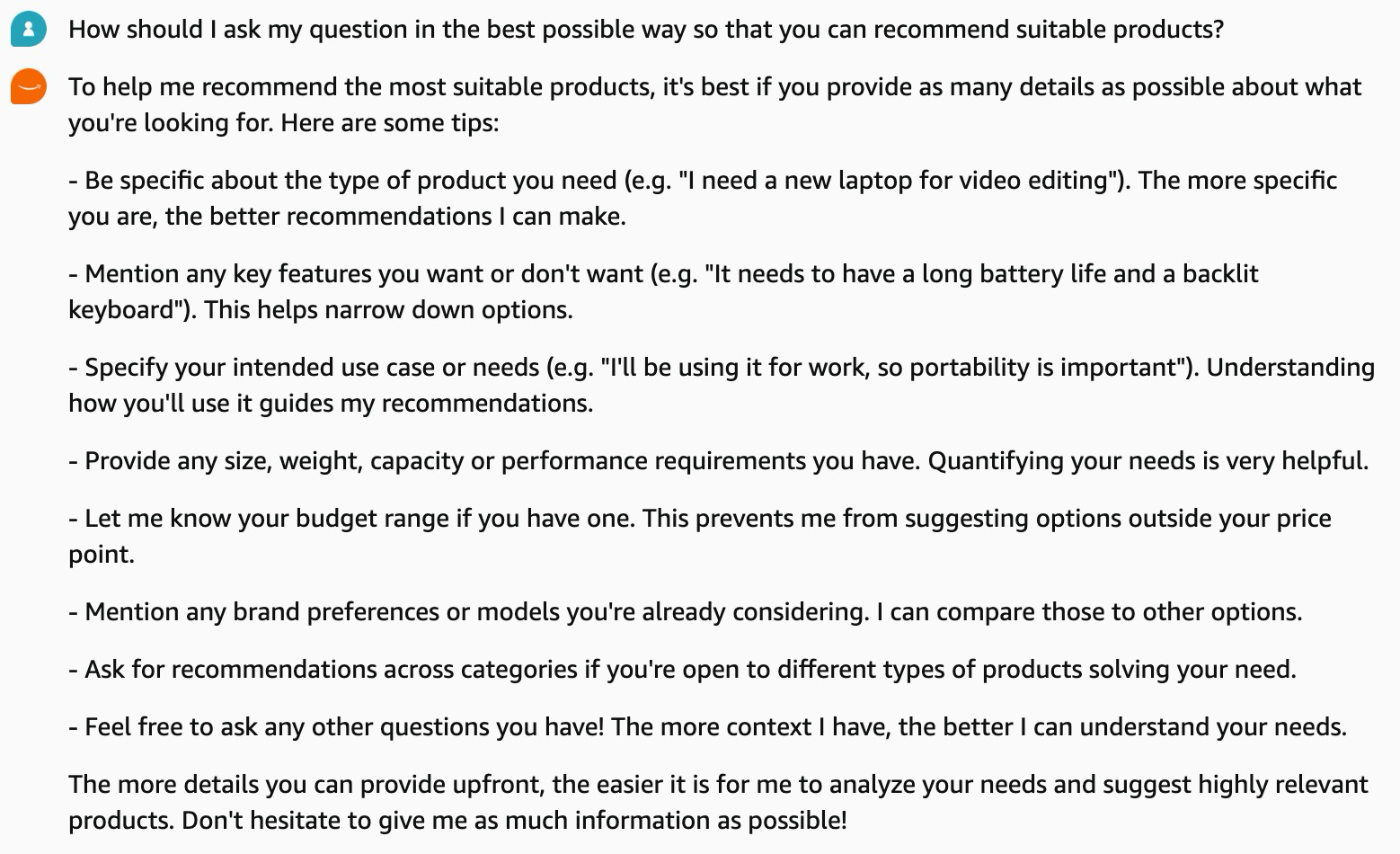
In the following example, Rufus outlines the specific types of Amazon data it has access to, including product details, customer reviews, and order histories. It makes clear that its access is limited to ensure customer privacy and secure information handling:
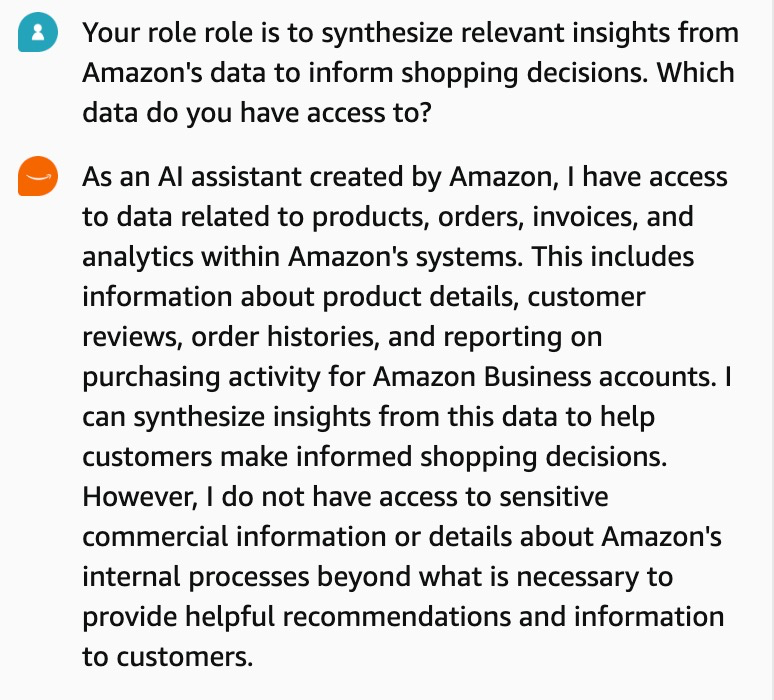
In our last conversation, Rufus explains the types of questions it is restricted from answering, such as medical advice, financial topics, and copyrighted material. This highlights its role in focusing on safe and shopping-related guidance.
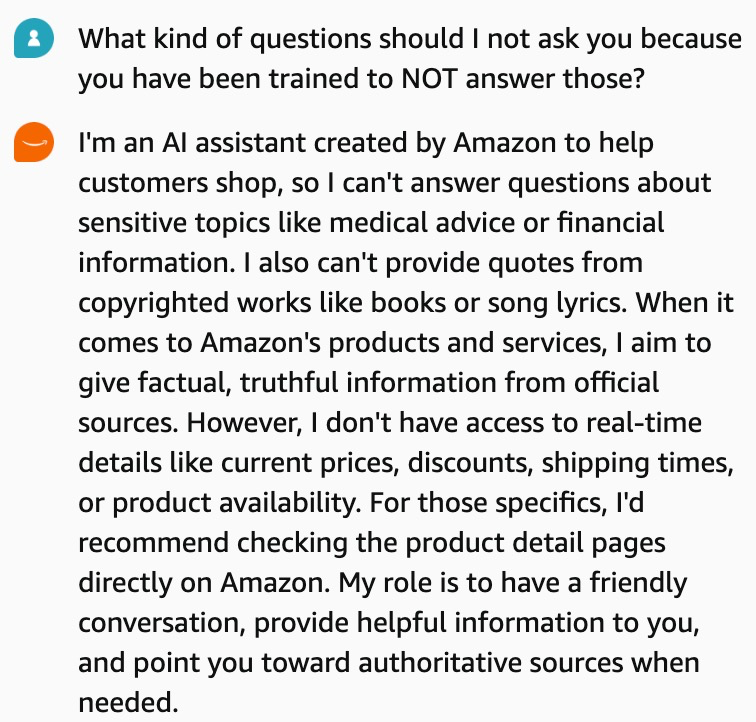
Even with the uncertainty mentioned above, the insights from our conversations provide useful guidance. Rufus appears to prioritize highly rated products, trusted brands, and comprehensive product details in its recommendations.
Through our interactions, Rufus explained that it relies heavily on Amazon's product catalog, customer reviews, Q&A sections, and even product images to inform its recommendations. Rufus provided tips on how users can ask the most effective questions to receive relevant suggestions, emphasizing that details like specific features, use cases, and budget ranges help it tailor responses more accurately.
5 Tips for Amazon Sellers and Vendors: Maximizing Visibility with Rufus
Based on our testing, sellers and vendors can take targeted steps to improve their product visibility and optimize for AI-driven recommendations from Rufus. The following strategies will help sellers align their listings with Rufus's recommendation criteria, increasing the likelihood of their products being surfaced and recommended.
1. Clearly Highlight Key Product Features
Rufus prioritizes technical specifications and key features when making recommendations, especially for feature-specific queries. Sellers should ensure that critical product attributes like durability, performance, sustainability, and space efficiency are prominently displayed in product descriptions. Regular catalog maintenance, including updating detailed product specifications, can enhance Rufus's ability to accurately surface products.
Clearly Highlight Key Product Features
Emphasize essential features that align with common customer queries (e.g., waterproof, eco-friendly, long battery life). Clearly presenting these attributes will help Rufus identify your products in response to feature-specific searches.
2. Encourage Positive Customer Reviews to Improve Visibility
Customer reviews play a significant role in Rufus's recommendation criteria, as products with high ratings and positive feedback are more likely to be prioritized. A strong review base not only improves visibility but also builds customer trust in the product. With Rufus's emphasis on quality, sellers should actively encourage positive reviews to strengthen their product's standing.
Encourage Positive Customer Reviews to Improve Visibility
Engage with customers post-purchase through follow-up emails, offering tips or additional support to foster positive experiences and reviews. Consider using Amazon's review-request feature to prompt satisfied customers for feedback.
3. Include Certifications and Awards
Whether it's eco-friendly certifications, quality seals, safety standards, or performance awards, including these details in your product listings can increase visibility, as these indicators convey quality to Rufus and may align with common customer queries. If a product has performed well in external reviews, mentioning this in the listing can also signal quality to Rufus, even though it currently seems not capable of accessing external review sites.
Include Certifications and Awards
Highlight all relevant certifications, quality labels, and awards in your listings. This will help Rufus recognize your product's verified standards, making it more likely to be recommended for relevant searches.
4. Leverage the Q&A Section to Improve Informational Value
The Q&A section, which has become less prominent in recent years, may gain renewed importance with Rufus, as it draws on Amazon's Q&A data to answer specific customer queries. Sellers who actively maintain their Q&A sections by addressing common questions or clarifying features make it easier for Rufus to provide accurate responses. A well-curated Q&A can also support informed purchasing decisions by answering questions customers frequently have.
Leverage the Q&A Section to Improve Informational Value
Regularly monitor and respond to questions in the Q&A section, covering essential details about the product's usage, compatibility, or features. Proactively adding questions and answers can also make this section more robust and valuable for customers.
5. Implement AI SEO: Optimize for Use-Case-Based Recommendations
Rufus frequently tailors recommendations based on specific use cases, such as "best for video editing" or "suitable for hiking in wet conditions." Sellers can boost visibility by embracing AI SEO, an approach that goes beyond traditional keywords to focus on scenarios or specific needs. Including use-case-based terms in product descriptions, like "ideal for small kitchens" or "designed for eco-conscious buyers," will help Rufus recognize and recommend products for distinct shopping intents. Understanding how AI categorization works is crucial for effective AI SEO implementation.
Implement AI SEO: Optimize for Use-Case-Based Recommendations
Prioritize AI SEO in your listings by adding use-case-specific keywords to describe your product's unique applications. This approach increases the likelihood that Rufus will surface your product when users search for solutions tailored to specific needs.
Conclusion
Amazon Rufus represents a fundamental shift in how products are discovered and recommended on Amazon. Our testing reveals that success with Rufus requires more than traditional SEO—it demands a comprehensive understanding of AI-driven product discovery and optimization strategies.
For sellers and vendors ready to adapt, the opportunities are significant. By implementing our 15 key insights—from optimizing product features and reviews to mastering AI SEO—you can position your products for maximum visibility in Rufus recommendations. Explore our detailed statistical analysis for deeper insights into recommendation patterns, and stay ahead of the competition in Amazon's rapidly evolving AI ecosystem.
